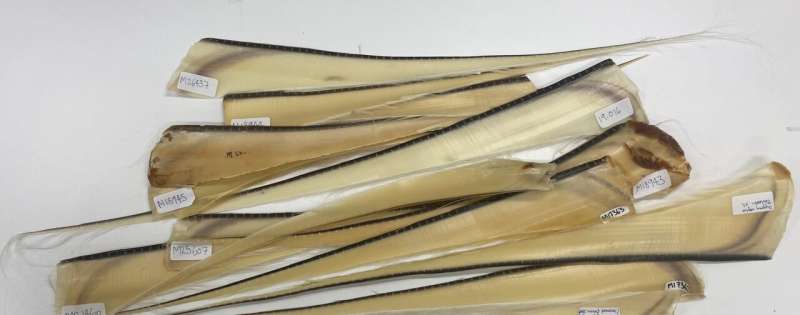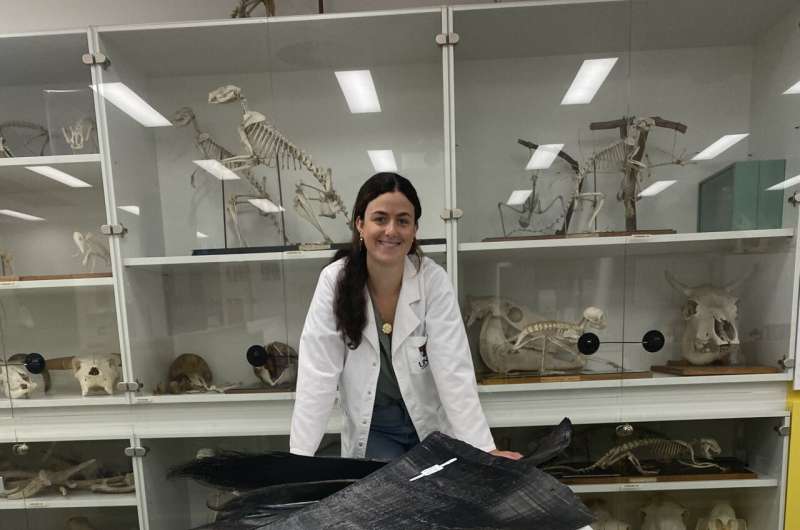This article has been reviewed according to Science X's editorial process and policies. Editors have highlighted the following attributes while ensuring the content's credibility:
fact-checked
peer-reviewed publication
trusted source
proofread
Scientists solve 'enigma' of pygmy right whales' feeding habits

Researchers have shown from stable isotope ratios in the baleen of pygmy right whales that this species of baleen whales remains in waters off southern Australia year-round and feeds on Australian krill and copepods. Unlike larger relatives, they don't make seasonal migrations to Antarctic regions.
Pygmy right whales (Caperea marginata) are the smallest, "most enigmatic," and probably least studied of all baleen whales. Baleen act like sieves in the mouth of baleen whales, which allow seawater to pass but trap small prey items like zooplankton and small fish.
Pygmy right whales are rarely seen in the wild. Reason for this may be their relatively small size (6.5 meters long and weighing up to 3.5 tons), sparse distribution, and inconspicuous behavior, especially compared to the boisterous humpback whales. Historically, whalers rarely bothered hunting them. The little we know about them is mainly based on beached animals.
"Here we show that pygmy right whales don't behave like most other baleen whales: they don't make long cross-ocean migrations," said Dr. Tracey Rogers, a professor of ecology and evolution at the University of New South Wales in Australia. "Instead, they are homebodies, who remain near the coast of southern Australia year-round, where they breed and feed on krill and copepods."
Rogers is the senior author on a new study in Frontiers in Marine Science, which demonstrated that pygmy right whales are restricted to mid-latitude waters and likely inhabit regions like the eastern Great Australian Bight (between Cape Catastrophe and Cape Pasley) and the region dominated by the Bonney Upwelling, between Portland and Robe. Here, south-eastern winds drive cold, nutrient-rich water from the depths to the surface between November and May, providing a food bonanza for seabirds and marine life.
Beached whales
The researchers measured the ratio between stable nitrogen isotopes 15N and 14N (the δ15N value) and between stable carbon isotopes 13C and 12C (the δ13C) value) in the baleen plates of 14 adult pygmy right whales, to infer their diet and habitat use. These included both females and males that had stranded between 1968 and 2019 on the Tasmanian or southern Australian coast. The baleen plates were on loan from the South Australian Museum in Adelaide.
"Baleen is made of keratin, like our fingernails, and grows throughout the life of the whale," explained lead author Adelaide Dedden, a doctoral student in Rogers' research group. "As a stable tissue, baleen provides an ideal long-term signal to look at their diet and habitat use."
Because animals derive their nitrogen and carbon exclusively from food, the isotope ratios in their tissues reflect those of their prey. Isotope ratios increase in a regular pattern across trophic levels within the food web, with phytoplankton having the lowest values, and apex predators the highest. By comparing the δ15N and δ13C values measured in baleen to those published for a range of possible prey, Dedden and the team could deduce which species are on the menu of pygmy right whales.

Not like other baleen whales
The results showed that the isotope ratios in the baleen of pygmy right whales closely match those of copepods and krill species from regions rich in zooplankton off Australia.
In contrast, there was no correspondence with isotope ratios of Antarctic krill, which means that pygmy right whales don't make seasonal migrations to the Antarctic, like many other species of baleen whales do.
Likewise, because the isotope ratios didn't match those of pelagic fish, the authors deduced that unlike larger species of baleen whales, pygmy right whales don't feed on fish.
The restricted, mid-latitude range of pygmy right whales and their reliance on specific prey puts them at risk, warned the authors.
"As large-bodied mammals who feed on tiny prey, pygmy right whales need to consume vast quantities of food. This makes them vulnerable to changes in their local environment. Their home, the temperate oceans of the southern hemisphere, is warming at an alarming rate. We plan to study next how they will respond to this change," said Rogers.
More information: Stable isotopes infer the diet and habitat of the enigmatic pygmy right whale (Caperea marginata) off southern Australia, Frontiers in Marine Science (2023). DOI: 10.3389/fmars.2023.1190623. www.frontiersin.org/articles/1 … rs.2023.1190623/full
Journal information: Frontiers in Marine Science
Provided by Frontiers





















